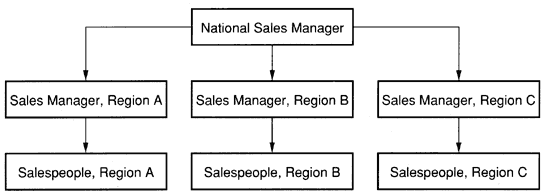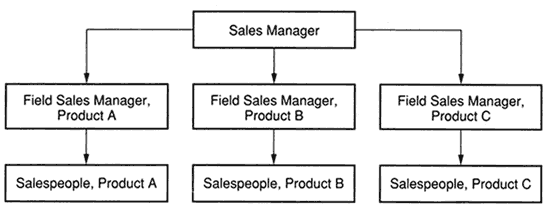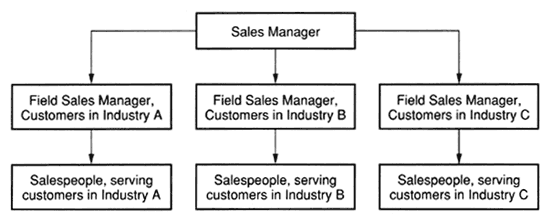MARKETING AND SALES MANAGEMENT
CHECK POINT 95: SALES ORGANIZATION
Please Select Any Topic In Check Point 95 Below And Click. |
| |
| |
|
DO I NEED TO KNOW THIS CHECK POINT?
|
|
1. THE SALES MANAGEMENT FUNCTION |
 |
|
THE SALES MANAGEMENT FUNCTION |
Business owners and sales managers must pay maximum attention to the development of a dynamic sales organization to ensure that the company will meet its overall business objectives and achieve the desired level of profitability in a highly competitive marketplace.
The implementation of marketing plans and promotion programs is effected by active selling of products and services in the marketplace. It is essential, therefore, to establish a suitable sales organization to meet relevant marketing objectives and to develop a Sales Management Function within the company.
The sales management function does not stand in isolation from other organizational responsibilities. On the contrary, it represents a part of a well-integrated system of functions as illustrated below. |
FIVE AREAS OF A COMPANY'S ACTIVITIES

|

|

|

|

|
General
Administration
Management
Function |
Human
Resources
Management
Function |
Financial
Management
Function |
Operations
Management
Function |
Marketing
And Sales
Management
Function |
|
| |
CONNECTION BETWEEN MARKETING
AND SALES MANAGEMENT FUNCTIONS
The Sales Management Function represents an integral part of the marketing management function. The sales manager, therefore, is responsible for developing an effective Sales Organization in order to implement all aspects of the company's marketing plan. |
|
|
|
2. THE SALES ORGANIZATION DEVELOPMENT PROCESS |
 |
|
THE SALES ORGANIZATION DEVELOPMENT PROCESS
The Sales Organization Development Process entails creation of a framework in which human and material resources can be utilized in the most efficient manner. Thus, the prime task of the sales manager is to develop a suitable organizational structure that will stimulate all employees toward effective performance.
Since the sales organization development process represents a continuous task that is carried out in a constantly changing environment, it is essential to ensure high flexibility of the Sales Organizational Structure. This is particularly important when a company plans to accomplish specific tasks outlined below. |
REASONS FOR A FLEXIBLE SALES ORGANIZATIONAL STRUCTURE |
No. |
Details |
1. |
To introduce new products or services into the market. |
2. |
To develop new sales territories. |
3. |
To meet constantly changing customers' needs. |
4. |
To establish another sales branch. |
|
There are several important issues that need to be addressed during the sales organization development process as outlined below. |
SALES ORGANIZATIONAL ISSUES |
No. |
Details |
1. |
To delegate responsibility, authority, and accountability in the sales department. |
2. |
To establish a routine sales reporting procedure. |
3. |
To develop a specialized range of sales activities and sales training. |
4. |
To establish a centralized or decentralized control over sales activities. |
|
The basic Sales Organization Development Process entails four steps outlined below. (49) |
STEPS IN THE SALES ORGANIZATION DEVELOPMENT PROCESS

Step 1: Determine The Tasks That Must Be Performed To Implement The Sales Plan, e.g. Forecasting, Prospecting, Selling, Order-Taking.

Step 2: Classify The Tasks And Group Them Into Related Sets Of Activities On The Basis Of Product, Customer, Or Sales Territory Requirements.

Step 3: Assign A Set Of Activities To An Individual Position Or Positions.

Step 4: Establish Supervision And Reporting Relationships Between Positions. |
|
|
3. FACTORS IN A SALES ORGANIZATION DEVELOPMENT PROCESS |
 |
|
THE UNITY OF COMMAND PRINCIPLE |
One important consideration of the sales organization development process is the Unity Of Command Principle. This principle suggests that each employee should report to only one person within the organization.
This is a general principle that is particularly useful in the sales management environment. When employees report to more than one individual, they may be given contradicting instructions that can, in turn, cause ineffective performance. It is essential, therefore, to prevent such a condition to avoid confusion among sales employees. |
SPAN OF CONTROL |
Another issue that should be considered by the sales manager relates to the Span Of Control, or the number of subordinates that can be effectively supervised by one manager.
The importance of this issue depends upon the size of the sales organization and is particularly critical for larger companies. Small and medium-sized organizations usually employ a moderate number of sales people and seldom experience problems caused by an excessive span of control. |
CENTRALIZATION OR DECENTRALIZATION OF CONTROL |
The sales manager should also consider the issue of Centralization Or Decentralization Of Control over the company's sales activities.
A small organization normally starts its operations from one office, and management exercises centralized control over sales force activities. When the organization grows and develops business relations with customers in different geographic locations, however, it may be useful to decentralize control over the sales force activities. This may require a branch to be opened in a suitable geographic location in order to ensure effective service of local customers.
Decentralization of sales activities helps minimize the travel time and expenses incurred by sales people and maximize the quality of sales service provided by customers. |
ORGANIZATIONAL SPECIALIZATION |
Finally, important consideration should be given by the sales manager to the issue of Organizational Specialization.
Since companies build their activities around customer requirements, it is essential to develop a sales organization that will provide the most effective service in the marketplace. Several types of organizational specialization could be considered by the sales manager as illustrated below. |
TYPES OF THE SALES ORGANIZATIONAL SPECIALIZATION
 |
|
 |
|
 |
|
 |
Geographic
Specialization |
|
Product
Specialization |
|
Customer
Specialization |
|
Functional
Specialization |
| |
|
|
|
|
4. GEOGRAPHICALLY-SPECIALIZED SALES ORGANIZATION |
 |
|
GEOGRAPHICALLY-SPECIALIZED SALES ORGANIZATION |
Geographic Specialization is particularly suitable for an organization that operates in widespread geographic markets.
In this type of organization, each sales person is assigned to sell all products to all customers within a specified geographic location. A typical structure of a Geographically-Specialized Sales Organization is illustrated below. |
| |
 |
The main advantages and disadvantages of the geographically-specialized organization structure are outlined below. |
GEOGRAPHICALLY-SPECIALIZED SALES ORGANIZATION |
Advantages |
Disadvantages |
One of the advantages of this structure is that it stimulates development of strong ties between sales people and their customers. In addition, travel time and selling costs can be substantially reduced because each sales person covers a limited sales territory. |
One of the disadvantages of this structure is that a particular sales person can handle only a limited number of uncomplicated products or product lines. |
|
|
|
|
5. PRODUCT-SPECIALIZED SALES ORGANIZATION |
 |
|
PRODUCT-SPECIALIZED SALES ORGANIZATION |
Product Specialization is generally used by industrial organizations that offer various lines of products to the market.
This type of structure is effective in the distribution of different highly-technical products. In this type of organization, each sales person is trained to handle a particular product or product line. Thus, the number of sales people depends upon the variety of products handled by the organization.
A typical structure of a Product-Specialized Sales Organization is illustrated below. |
| |
 |
The main advantages and disadvantages of the product-specialized sales organization are outlined below. |
PRODUCT-SPECIALIZED SALES ORGANIZATION |
Advantages |
Disadvantages |
One of the advantages of this structure is that it stimulates development of sound product knowledge by sales people. This, in turn, enables the company to provide effective product and technical support to their customers. |
One of the disadvantages of this structure is that each sales person must cover a much larger territory which increases traveling time and selling expenses. |
|
|
|
|
6. CUSTOMER-SPECIALIZED SALES ORGANIZATION |
 |
|
CUSTOMER-SPECIALIZED SALES ORGANIZATION |
Customer Specialization is frequently used by organizations that offer their products to different industries. In this type of an organization, each sales person is assigned to a particular industry or individual customer.
A typical Customer-Specialized Sales Organization structure is illustrated below. |
| |
 |
The main advantages and disadvantages of the customer-specialized sales organization are outlined below. |
CUSTOMER-SPECIALIZED SALES ORGANIZATION |
Advantages |
Disadvantages |
One of the advantages of this structure is that it allows the sales person to become an expert on the customers' operations and stimulates the development of strong company-customer relations. |
One of the disadvantages of this structure, similar to the disadvantages of product specialization, are that each sales person must cover a wide territory, spend more time on the road, and incur high selling expenses. |
|
|
|
|
7. FUNCTION-SPECIALIZED SALES ORGANIZATION |
 |
|
FUNCTION-SPECIALIZED SALES ORGANIZATION |
Functional Specialization is most appropriate for organizations that offer relatively narrow product lines to non-segmented and geographically concentrated markets. In this type of organization, each sales person is assigned particular functional responsibilities for the entire range of customers.
Two basic responsibilities that are usually assigned to sales people in Function-Specialized Sales Organizations are outlined below. |
TWO MAIN RESPONSIBILITIES
IN A FUNCTION-SPECIALIZED SALES ORGANIZATION |
No. |
Details |
1. |
Developing new accounts. |
2. |
Maintaining existing ones. |
|
| |
UNDERSTAND VARIOUS TYPES OF SALES SPECIALIZATION |
In a Functional Sales Organization, new accounts are generally developed by sales executives and existing accounts are maintained by specially trained sales personnel. Functional specialization has limited application for small and medium-sized organizations and is used infrequently.
It is essential that the sales manager understands the different types of specialization that can be used in the sales organization development process. Companies with widespread markets usually use geographic specialization, and those with diverse product lines find product specialization effective. If customers have highly-specialized needs, customer specialization is frequently used, and functional specialization is applied when team selling is more appropriate. |
|
|
|
8. JOB DESCRIPTIONS IN A SALES ORGANIZATION |
 |
|
JOB DESCRIPTIONS IN A SALES ORGANIZATION |
Once a sales organization is established, management must prepare several Job Descriptions for key positions within the sales department. Availability of job descriptions will help management to provide sales employees with specific guidelines related to their work with the company and avoid any possible misunderstandings and even help prevent conflicts.
Various issues related to job descriptions and job specifications are discussed in detail in Tutorial 2. Each job description should contain the following information outlined below. |
ELEMENTS OF A JOB DESCRIPTION |
No. |
Details |
1. |
The job title. |
2. |
The job summary. |
3. |
Details of accountability. |
4. |
Details of responsibility and duties. |
5. |
Details of authority. |
6. |
Participation in management teams. |
|
In order to provide a clear guidance to employees within the sales department, the job descriptions should be prepared for the following positions, as outlined below. |
JOB DESCRIPTIONS IN A SALES DEPARTMENT |
No. |
Details |
1. |
Sales manager. |
2. |
Sales consultant. |
3. |
Internal sales consultant. |
|
Example of a job description for the Sales Manager is illustrated next. Additional examples of job descriptions for Sales Consultant and Internal Sales Consultant are presented in Tutorial 5. |
|
|
|
9. SMALL BUSINESS EXAMPLE
JOB DESCRIPTION FOR A SALES MANAGER |
 |
|
JOB DESCRIPTION FOR A SALES MANAGER
| • |
Title: Sales Manager |
| • |
Appointed By: President or Marketing Executive. |
| • |
Responsible To: President or Marketing Executive. |
| • |
Responsible For: The attainment of pre-determined sales objectives in accordance with the overall company's strategy, policies, budgets, and the marketing plan. |
| • |
Function: To establish and maintain a sales force motivated to achieve desired goals through demonstration of personal selling ability, administrative, and financial skills commensurate with sales activities. |
| • |
Duties And Responsibilities: |
| 1. |
Determine, in collaboration with the marketing executive, the types of outlets best suited for the sale of the company's products and/or services. |
| 2. |
Determine in what areas the company's products and/or services are likely to achieve desired results. |
| 3. |
Recruit, in collaboration with the president or human resources manager suitable sales employees. |
| 4. |
Allocate adequate number of employees for selling activities in designated areas. |
| 5. |
Establish individual sales targets commensurate with area's potential sales revenues. |
| 6. |
Establish and maintain a sales routing or sales call system. |
| 7. |
Allocate appropriate transport to sales employees. |
| 8. |
Devise suitable recording systems for customers and potential buyers together with adequate monitoring systems for all sales activities. |
| 9. |
Ensure that suitable product knowledge and selling methods are a regular feature of in-house training. |
| 10. |
Establish correct budgeting procedures for all sales activities in collaboration with the marketing executive. |
| 11. |
Monitor and control all financial expenditures associated with the selling function. |
| 12. |
Advise the president, the marketing executive, and financial executive on all aspects of remuneration, bonus, and incentive schemes for sales employees. |
| 13. |
Ensure that all sales employees promote the desired company image by their appearance and conduct. |
| 14. |
Ensure that all sales employees are fully conversant with the overall objectives of the company and know exactly what role each has to play in achieving them. |
| 15. |
Conduct regular performance appraisal of sales employees and record all relevant findings in the individual sales person's performance file. |
| 16. |
Conduct regular sales meetings to ensure that each sales person receives the most current sales and corporate information on a regular basis. |
| 17. |
Participate in the company's management meetings to provide the management staff with all information relevant to the sales department's performance. |
| • |
Participation In Management Meetings: |
| 1. |
Chairperson in the weekly sales management meetings. |
| 2. |
Participant in the company's weekly/bi-weekly/monthly management meetings. |
|
|
|
10. FOR SERIOUS BUSINESS OWNERS ONLY |
 |
|
ARE YOU SERIOUS ABOUT YOUR BUSINESS TODAY? |

Reprinted with permission. |
|
11. THE LATEST INFORMATION ONLINE |
 |
|
|
| |
LESSON FOR TODAY:
Make Sure That Your Sales Organization Supports
Your Business, And Not The Other Way Around!
Joe Griffith (Adapted) |
| |
|







